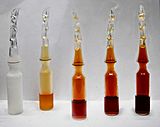Dinitrogen tetroxide facts for kids
Quick facts for kids Dinitrogen tetroxide |
|
|---|---|
 |
|
| IUPAC name | Dinitrogen tetraoxide |
| Other names | Dinitrogen(II) oxide(-I) |
| Identifiers | |
| CAS number | |
| PubChem | |
| EC number | 234-126-4 |
| ChEBI | CHEBI:29803 |
| RTECS number | QW9800000 |
| SMILES | [O-] [N+](=O)[N+]([O-])=O |
|
InChI
InChI=1/N2O4/c3-1(4)2(5)6
|
|
| Properties | |
| Molecular formula | N2O4 |
| Molar mass | 92.011 g/mol |
| Appearance | colourless liquid / orange gas |
| Density | 1.44246 g/cm3 (liquid, 21 °C) |
| Melting point |
−11.2 °C, 262 K, 12 °F |
| Boiling point |
21.69 °C, 295 K, 71 °F |
| Solubility in water | reacts |
| Vapor pressure | 96 kPa (20 °C) |
| Refractive index (nD) | 1.00112 |
| Structure | |
| Molecular shape | planar, D2h |
| Dipole moment | zero |
| Thermochemistry | |
| Std enthalpy of formation ΔfH |
+9.16 kJ/mol |
| Standard molar entropy S |
304.29 J K−1 mol−1 |
| Hazards | |
| MSDS | External MSDS |
| EU classification | Very toxic (T+) Corrosive (C) |
| EU Index | 007-002-00-0 |
| NFPA 704 |
|
| R-phrases | R26, R34 |
| S-phrases | (S1/2), S9, S26, S28, S36/37/39, S45 |
| Flash point | Non-flammable |
| Related compounds | |
| Related nitrogen oxides | Nitrous oxide Nitric oxide Dinitrogen trioxide Nitrogen dioxide Dinitrogen pentoxide |
| Except where noted otherwise, data are given for materials in their standard state (at 25 °C, 100 kPa) | |
Dinitrogen tetroxide, also known as nitrogen tetroxide or dinitrogen tetraoxide, is a chemical compound. Its chemical formula is N2O4. It contains nitrogen in its +4 oxidation state. It contains nitrogen and oxide ions.
Contents
Properties
It is a colorless gas, although it is sometimes polluted with nitrogen dioxide. It is very corrosive and a strong oxidizing agent. It can ignite on contact with hydrazine. It can be made by bonding two nitrogen dioxide molecules together at a low temperature or a high pressure.
Preparation
It is made by bonding nitrogen dioxide molecules together in pairs.
Uses
It is used as a rocket propellant, along with hydrazine. This mixture is good since it does not have to be ignited. It is used similar to nitrogen dioxide to make nitric acid. It can react with metals to make nitrates.
Safety
Dinitrogen is highly toxic and corrosive. Some astronauts breathed it and had to go to a hospital.
Related pages
See also
 In Spanish: Tetróxido de dinitrógeno para niños
In Spanish: Tetróxido de dinitrógeno para niños




